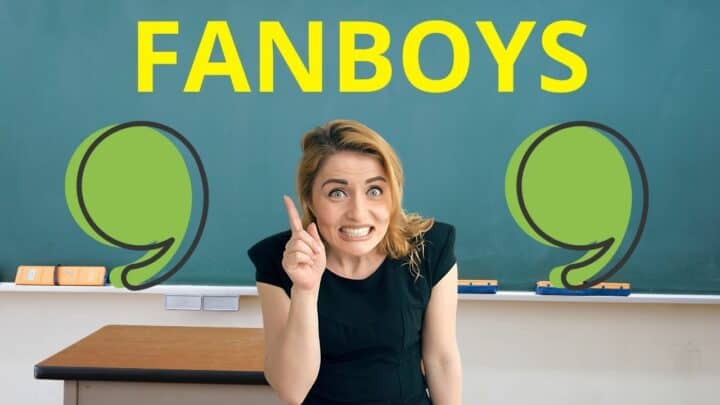Just like your dog’s collar, guitar pick, and cigarette filter, every punctuation mark serves a purpose in the world of written language.
And, notwithstanding how insignificant a word may superficially look like, it surely plays a significant role in forming a sentence as well.
Today, we’ll look into punctuating coordinating conjunctions in English, namely, for, and, nor, but, or, yet, and so, or more popularly known as the FANBOYS.
Where does the comma go in FANBOYS?
When creating compound sentences, meaning two independent clauses having the ability to stand as separate and complete ideas, the comma goes before FANBOYS (for, and, nor, but, or, yet, so). We must not place any commas when coordinating conjunctions only link words, phrases, or clauses that cannot be regarded as complete ideas.
Placing a comma before FANBOYS
Just like any other system, language also follows some recognizable patterns that guide humans in using it effectively, albeit not all the time.
This simply means that, although there are predictable places where punctuation marks should go, a writer may also freely tweak the “rules” every once in a while.
Knowing these instances will surely make our written output uncluttered and emphatic, which is pivotal in aligning the thoughts of the writer and the reader.
Bear in mind that we will only be dealing with the conjunctive sense of FANBOYS in this text, and thus, the adverbial senses, for instance, of “so” and “yet” will not be included.
Now, let’s begin by understanding when we should place a comma before FANBOYS.
When FANBOYS are used in a compound sentence
A compound sentence is a type of sentence structure marked by the presence of two independent clauses.
An independent clause is a clause that can stand alone as an idea or, put simply, a complete sentence on its own.
To know whether the clause is independent, we should look for the presence of at least one subject and one verb.
Here are two independent clauses represented as separate sentences for clarity.
If we want to connect these two ideas using a coordinating conjunction, we can use “for” to express the causal relationship.
Also, a comma should come before “for” to mark the independence of each clause in the sentence.
The same rule goes with the rest of the coordinating conjunctions, as listed below.
Again, a comma must precede any of the coordinating conjunctions in FANBOYS when it links two independent clauses, which makes up compound sentences.
When FANBOYS appear after an introductory element
The next necessary pre-comma placement happens when any of the FANBOYS appear after any introductory information.
A sentence’s intro can be as short as a single word or as long as a dependent clause.
Introductory elements are set off with commas to signal the reader that they are not the “juice” of the sentence yet.
Therefore, any coordinating conjunction appearing after an introductory expression should automatically be preceded with a comma too.
Technically, an introductory expression is not necessarily grammatically significant, yet it exists in written language because it adds meaning to the whole sentence.
Any word or set of words that can be defined this way is stylistically known as “parenthetical” elements.
Although a sentence may be perfectly well-formed without intros, adding one generally enriches its holistic unit of meaning, making ideas clearer and interconnected.
Here are some examples of the FANBOYS appearing after introductory pieces of information.
In all examples presented above, “and,” “or,” and “yet” actually introduce “parenthetical” information interrupting the sentences midway.
Therefore, we can also deduce that any coordinating conjunction positioned after introductory elements is often used to only add an emphatic effect.
We can test the essentiality of the information introduced by FANBOYS by simply removing it from the sentence.
If what remains still makes up a complete sentence with one unit of meaning, then the comma must be essentially placed as well.
As far as I know, she has made up her mind.
See how the sentences still work without the information introduced by FANBOYS?
That brings us to our next guideline on placing a comma before FANBOYS when they appear after parenthetical elements, which is pretty easy to understand.
When FANBOYS appear after parenthetical elements
Here, we’ll highlight the occurrence of the pre-comma to FANBOYS when they are positioned after a mid-sentence interruptive information.
Again, sentences can be tweaked to match how the writer wants to convey his or her inner thoughts.
And thus, any of the FANBOYS appearing right after an interruptive parenthetical insertion automatically necessitates a pre-comma placement.
Here are some examples using “for,” “nor,” “but,” and “so” to illustrate the explanation above.
In like manner with the last subsection, complete compound sentences will still be left even after removing the parenthetical interruptions.
Placing a comma after FANBOYS
Since we’ve already discussed when to place commas before FANBOYS, let’s also find out the after-comma guidelines.
When FANBOYS are used as an introductory element
As a general rule, a comma should always come after introductory elements in a sentence.
This also suggests that a comma should also be found after FANBOYS when and if they are used as introductory expressions.
We can observe this particular usage with “and,” “but,” “or,” “yet,” and “so,” especially in casual texts usually as convenient replacements for formal connective devices.
“And” may be used as a substitute for “moreover,” “but” for “however,” “or” for “alternatively,” “yet” for “besides,” and “so” for “therefore.”
In contrast with the rather pedantic belief that we must never use these conjunctions at the beginning of a sentence, it is actually possible to do so.
This is true for as long as the context of the writing is non-technical such as proses and blogs, contrary to academic papers.
When FANBOYS are subsequently followed by parenthetical elements
We also learned earlier that any parenthetical information needs to be encapsulated with commas wherever it appears in a sentence.
From this, we can deduce that we may also find parenthetical elements inserted after coordinating conjunctions, especially midsentence.
Hence, a comma should also appear after FANBOYS when this happens, which is usually a stylistic choice instead of a syntactical one.
Here are some of the typical usage of parenthetical insertion after “and,” “but,” “or,” “so,” and “yet.”
Do not place a comma before or after FANBOYS when…
Earlier, we learned that we need a comma in joining two independent clauses joined by FANBOYS, didn’t we?
This rule often gets overgeneralized to the point that people use commas before FANBOYS even if a dependent clause follows afterward.
This usually happens particularly with “but.”
Incorrect: It looks strange, but cool.
Correct: It looks strange but cool.
Incorrect: It looks strange but it is cool.
Correct: It looks strange, but it is cool.
Or, others might also mistakenly think that the comma should rather come after the mid-sentence FANBOYS because of how we normally pause in the spoken context.
This is also common with the conjunction “and” because of its additive function.
When speaking, adding an idea may not necessarily happen instantly, so we may need some time to think, making us pause after “and.”
When we overgeneralize this act of pausing after “and” in writing, the result would be ungrammatical sentences.
Incorrect: Please come to the party this weekend and, you can also invite some of your friends.
Correct: Please come to the party this weekend, and you can also invite some of your friends.
Also, we should not place a comma after “and” if it only joins two words or phrases in a sentence.
Although we may tend to pause out of hesitation when speaking the following sentences, we should not imitate the pause in writing.
Incorrect: Dylan is talented and, handsome.
Correct: Dylan is talented and handsome.
Getting to know the essence of FANBOYS and commas
The English mnemonic device “FANBOYS” refers to the set of linking words that combine words, phrases, and clauses in a sentence.
It stands for “for,” “and,” “nor,” “but,” “or,” “yet,” and “so” which are called coordinating conjunctions.
Coordinating conjunctions, as the phrase suggests, “coordinates” or synchronizes grammatical elements that are of equal weight or importance.
Without them, we would not be able to express ideas harmoniously, not to mention recursively.
For example, you want to say that you have two pet dogs and you want to introduce their names.
Without “and” in the sentence above, you’ll be left with “Bullet Scotch” which could generally be interpreted as a compound name for only one dog.
So, if we apply this analogy to all coordinating conjunctions, then we would be speaking and writing at length all the time, which isn’t that efficient.
In the same vein, commas also serve a crucial purpose in writing, despite being puzzling most of the time.
Commas have been created to disambiguate texts, as well as guiding rhythm and drawing emphasis on certain ideas.
Without commas, a reader may easily get confused and lost in a jungle of textual characters, more likely known as letters and words.
Carelessly missing out on a necessary comma may dramatically alter the meaning of a statement.
Frequently Asked Questions on Comma With FANBOYS
What type of conjunctions are FANBOYS?
FANBOYS are called coordinating conjunctions, a type of conjunction that coordinates or synchronizes words, phrases, and clauses with equal grammatical weight or importance.
What does “FANBOYS” mean?
FANBOYS is a mnemonic device that stands for the seven coordinating conjunctions in English, namely, for, and, nor, but, or, yet, and so.
What are some examples of subordinating conjunctions?
Unless, because, if, since, provided that, although, and so that, are examples of subordinating conjunctions, the type of conjunction that links ideas in a complex sentence structure.
Conclusion
By this point, I hope I’ve been able to impart the idea that the written language is guided by rigid rules and, apparently, stylistic ones too.
This simply implies that language is indeed a living organism that continuously thrives for as long as humans exist.

Hey fellow Linguaholics! It’s me, Marcel. I am the proud owner of linguaholic.com. Languages have always been my passion and I have studied Linguistics, Computational Linguistics and Sinology at the University of Zurich. It is my utmost pleasure to share with all of you guys what I know about languages and linguistics in general.


